The Timeless Art of American Traditional Tattoos: [A Comprehensive Guide to Their History, Styles, and Iconic Imagery]
Welcome, tattoo enthusiasts and art lovers! In this in-depth exploration of the American Traditional Tattoo style, we’ll delve into the captivating world of bold lines, vibrant colors, and timeless iconography. Let’s begin our journey through history, design, and artistic mastery.
American Traditional Tattoos—also known as “Old School” or “Sailor Tattoos”—have captivated people for generations. Rooted in the American tattoo scene’s humble beginnings, this art form has transcended time and cultural boundaries. Today, it remains a popular choice for those seeking a lasting and meaningful statement on their skin.
Whether you’re a seasoned tattoo collector, an aspiring tattoo artist, or simply someone intrigued by the history and artistry behind American Traditional Tattoos, this comprehensive guide is for you.
So, without further ado, let’s dive into the fascinating world of American Traditional Tattoos!
The History of American Traditional Tattoos
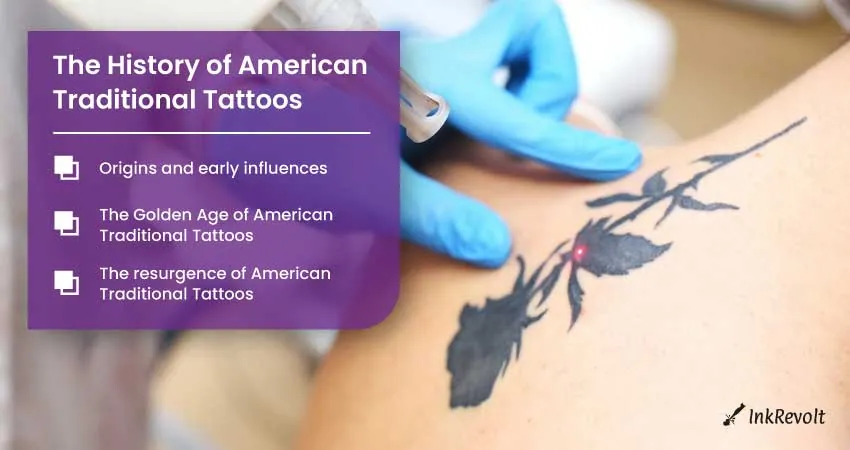
Embarking on a voyage through time, we’ll uncover the roots and development of American Traditional Tattoos, highlighting the key events and figures that shaped this enduring style.
Origins and early influences
The origins of American Traditional Tattoos can be traced back to a rich tapestry of cultural influences, particularly from Native American and European traditions.
- Native American tattoos: Indigenous peoples of North America have been using tattoos as a form of personal expression, spiritual connection, and cultural identity for centuries. Their designs often incorporated geometric patterns, animal totems, and natural elements, which have left a lasting impact on American Traditional Tattoos.
- European sailors and their tattoos: In the 18th and 19th centuries, European sailors, particularly the British, began collecting tattoos as souvenirs during their global voyages. As they ventured to the shores of America, their body art became interwoven with the emerging American tattoo culture, paving the way for the development of a distinct and recognizable style.
The Golden Age of American Traditional Tattoos
The period between the 1900s and 1950s is often hailed as the “Golden Age” of American Traditional Tattoos. During this time, several notable artists and pioneers emerged, crafting the iconic designs and techniques we associate with the style today.
- Norman “Sailor Jerry” Collins: A legendary tattoo artist, Sailor Jerry is synonymous with the American Traditional Tattoo style. He combined his artistic skills with his knowledge of electricity and mechanics to refine the tattoo machine and techniques. Sailor Jerry’s designs are famous for their bold lines, vivid colors, and nautical themes.
- Amund Dietzel: A Norwegian-born artist who settled in Milwaukee, Dietzel became known for his unique tattoo designs and exceptional artistic talent. He is often credited with helping to popularize American Traditional Tattoos in the Midwest and beyond.
- August “Cap” Coleman: A master of his craft, Cap Coleman was a tattoo artist in Norfolk, Virginia, and a central figure in the development of the American Traditional Tattoo style. Known for his precise line work and vibrant color palette, Coleman’s influence on the art form remains evident today.
The resurgence of American Traditional Tattoos
In the 1980s, American Traditional Tattoos experienced a revival, driven by a combination of factors, including tattoo television shows, social media, and celebrity influence.
- Tattoo television shows: Shows like “Miami Ink” and “LA Ink” brought tattoo culture into the mainstream, showcasing American Traditional Tattoos alongside other styles and sparking renewed interest in this classic art form.
- Social media: Platforms like Instagram and Pinterest have allowed tattoo artists and enthusiasts to share their work, connect with others, and foster an appreciation for American Traditional Tattoos among new generations.
- Celebrity influence: The visibility of tattoos on celebrities like Johnny Depp, Angelina Jolie, and Rihanna has contributed to the resurgence of American Traditional Tattoos, inspiring fans to explore this timeless style.
Characteristics and Styles of American Traditional Tattoos
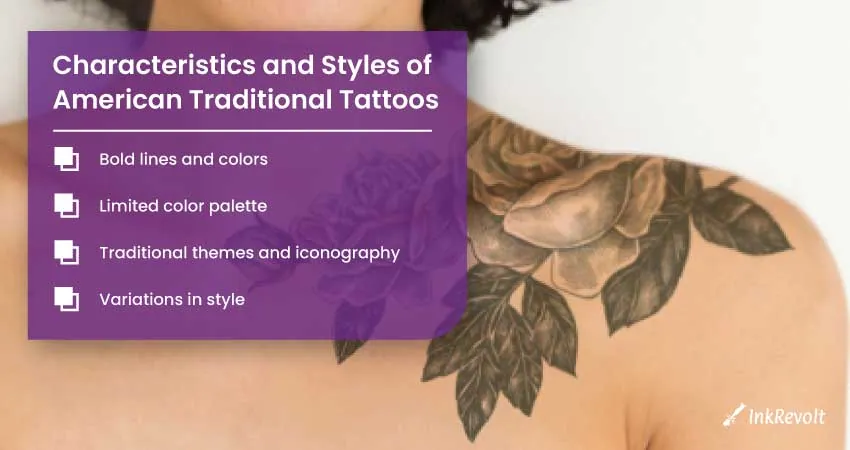
The American Traditional Tattoo style is known for its distinctive visual elements, which have evolved over time. Let’s explore the key characteristics and variations that define this classic art form.
Bold lines and colors
One of the most striking features of American Traditional Tattoos is their use of bold, black outlines and vibrant colors. This combination creates a sense of depth, contrast, and clarity, ensuring the tattoo remains visually appealing as it ages.
Limited color palette
The classic American Traditional Tattoo color palette consists of black, red, green, and yellow. This limited range of colors contributes to the style’s signature look, making it easily recognizable and timeless.
Traditional themes and iconography
American Traditional Tattoos often draw inspiration from a range of classic themes and symbols. Nautical imagery, animals, patriotic symbols, and floral designs are just a few examples of the motifs commonly found in this style. These iconic images often carry specific meanings, adding a deeper layer of significance to the tattoo.
Variations in style
While the classic American Traditional Tattoo style remains popular, several variations have emerged over time, reflecting the ongoing evolution of the art form.
- Classic American Traditional: This style adheres closely to the traditional characteristics, with bold lines, limited color palettes, and iconic imagery. It remains a popular choice for those seeking a timeless, vintage-inspired tattoo.
- Neo-traditional: Neo-traditional tattoos build on the foundations of American Traditional Tattoos, incorporating a broader range of colors, more detailed designs, and a fusion of traditional and contemporary themes. This style offers a modern twist while still honoring the roots of American Traditional Tattoos.
- Blackwork American Traditional: This variation focuses on the use of black ink and intricate shading techniques, creating a high-contrast, monochromatic look. Blackwork American Traditional Tattoos often feature the same iconic imagery, but with a distinctive visual flair.
Iconic American Tattoo Imagery and Meanings
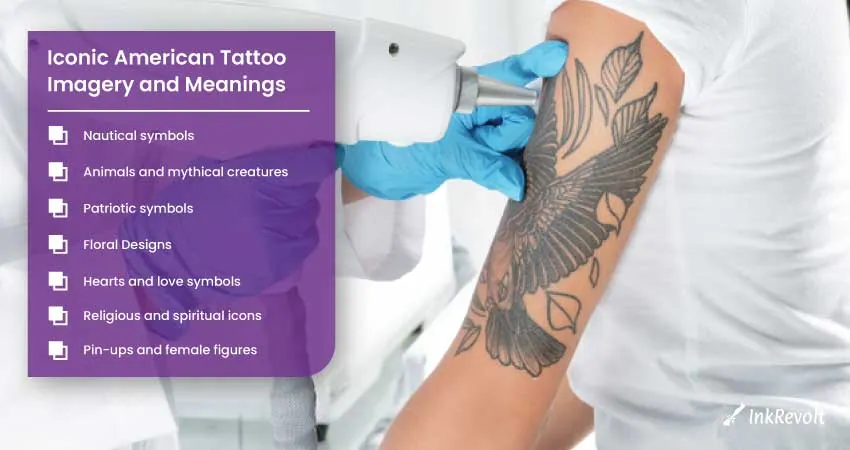
A key component of American Traditional Tattoos is their rich array of symbols, each imbued with unique meanings and historical significance. Let’s explore some of the most iconic imagery and the stories behind them.
Nautical symbols
Reflecting the style’s maritime origins, nautical symbols are a staple in American Traditional Tattoos.
- Anchors: Symbolizing stability, strength, and a safe return home, anchors are a popular choice for sailors and those with a connection to the sea.
- Ships: Sailors often opted for ship tattoos as a tribute to their profession and the adventures they embarked on. Ships can also symbolize exploration, freedom, and overcoming challenges.
- Compasses: Representing guidance, protection, and the ability to navigate through life’s challenges, compass tattoos hold deep personal meaning for many individuals.
Animals and mythical creatures
American Traditional Tattoos frequently feature animals and mythical creatures, each with their own symbolic meanings and associations.
- Eagles: As a symbol of freedom, strength, and courage, eagles are often depicted in American Traditional Tattoos. They may also represent patriotism, given their connection to the United States as the national bird.
- Wolves: Symbolizing loyalty, independence, and the wild spirit, wolf tattoos are a popular choice for those drawn to the animal’s fierce and mysterious nature.
- Dragons: These mythical creatures embody power, wisdom, and protection. Dragons in American Traditional Tattoos can also symbolize the struggle between good and evil, reflecting the duality of human nature.
Patriotic symbols
Patriotism and national pride are common themes in American Traditional Tattoos, with a range of symbols used to express these sentiments.
- American flag: The flag represents freedom, unity, and the values upon which the United States was founded. Incorporating the American flag into a tattoo design is a powerful way to show one’s love and loyalty to the country.
- Bald eagle: As the national bird of the United States, the bald eagle is a potent symbol of American pride, strength, and freedom.
- Military insignias: Many individuals choose to honor their service or the service of a loved one by incorporating military insignias into their American Traditional Tattoo designs.
Floral Designs
Floral designs are prevalent in American Traditional Tattoos, adding an element of beauty and symbolism to the artwork.
- Roses: Symbolizing love, passion, and beauty, roses are a versatile and popular choice for American Traditional Tattoos. Different colors can also convey various meanings, such as red for romantic love and black for loss or mourning.
- Peonies: Known for their lush, intricate petals, peonies represent prosperity, good fortune, and happiness. They are often chosen for their aesthetic appeal and positive connotations.
- Chrysanthemums: These flowers symbolize longevity, joy, and rejuvenation. Chrysanthemums are a popular choice for those seeking a visually striking and meaningful tattoo design.
Hearts and love symbols
Expressing love and affection through American Traditional Tattoos is a time-honored tradition, with various symbols used to convey these emotions.
- Heart with a banner: This classic design typically features a heart wrapped in a banner, often inscribed with a loved one’s name or a meaningful phrase. It symbolizes love, devotion, and the permanence of one’s feelings.
- Cupid: The Roman god of love, Cupid is often depicted as a cherubic figure with a bow and arrow. Cupid tattoos represent love, passion, and the desire for a deep romantic connection.
- Swallows: In American Traditional Tattoos, swallows are believed to symbolize love, loyalty, and the promise of a safe return home. Sailors often chose swallow tattoos as a reminder of their loved ones waiting for them onshore.
Religious and spiritual icons
Spiritual and religious themes are frequently incorporated into American Traditional Tattoos, reflecting the wearer’s beliefs and values.
- Crosses: As a symbol of faith, crosses are often chosen by those wishing to express their Christian beliefs through their tattoo. Crosses can also represent hope, sacrifice, and redemption.
- Praying hands: Depicting hands clasped in prayer, this iconic design symbolizes one’s devotion to a higher power, spiritual connection, and the importance of faith in one’s life.
- Sacred hearts: This religious symbol, featuring a heart surrounded by a crown of thorns and often accompanied by flames, represents the love and compassion of Jesus Christ. Sacred heart tattoos can signify divine love, devotion, and the transformative power of faith.
Pin-ups and female figures
Pin-ups and female figures have long been a staple in American Traditional Tattoos, embodying beauty, sensuality, and empowerment.
- Sailor girls: Sailor girl tattoos often depict a woman dressed in nautical attire, symbolizing the allure of the sea and the adventures it promises. These designs can also represent love, longing, and the enduring bond between sailors and their loved ones back home.
- Hula dancers: With their graceful movements and exotic appeal, hula dancers have become a popular motif in American Traditional Tattoos. These designs can represent a connection to Hawaiian culture, a love for travel and adventure, or simply an appreciation for beauty and artistry.
- Mermaids: These mythical creatures embody the mystery and allure of the ocean, often symbolizing femininity, seduction, and the untamed spirit of the sea. Mermaid tattoos are a captivating choice for those drawn to the enchanting world of folklore and legend.
The Tattooing Process: From Design to Aftercare
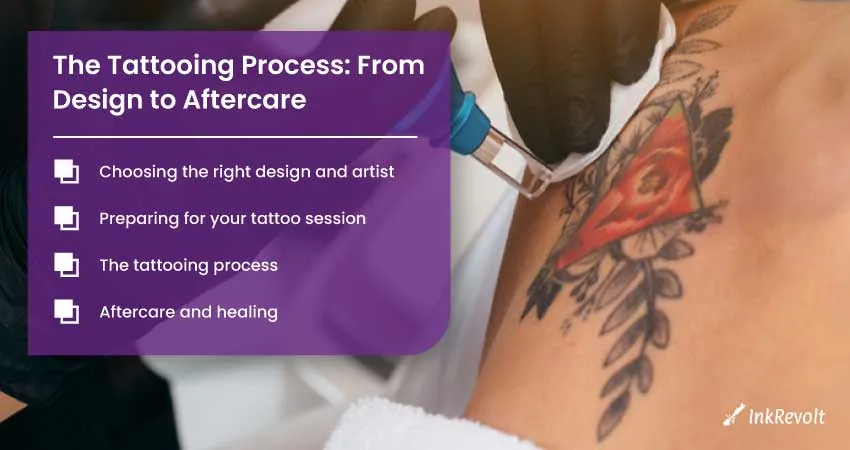
Understanding the tattooing process is crucial for anyone considering an American Traditional Tattoo. In this section, we’ll guide you through each step, from design selection to aftercare, ensuring a smooth and successful tattoo experience.
Choosing the right design and artist
Selecting the perfect design and finding an experienced tattoo artist are the first steps toward getting an American Traditional Tattoo.
- Research: Look for inspiration in online galleries, social media, or even books on tattoo history. Consider the meanings behind various symbols and choose a design that resonates with you.
- Consultation: Schedule a consultation with a reputable tattoo artist who specializes in American Traditional Tattoos. Discuss your design ideas, placement, and any questions you may have about the process.
Preparing for your tattoo session
Proper preparation can make your tattoo session a more enjoyable and comfortable experience.
- Rest: Get a good night’s sleep before your appointment to ensure you’re well-rested and relaxed.
- Eat: Have a nutritious meal before your session, as this can help stabilize your blood sugar levels and prevent lightheadedness or fainting.
- Hydrate: Drink plenty of water leading up to your appointment to keep your skin hydrated and healthy.
The tattooing process
Understanding what to expect during the tattooing process can help ease any anxiety or concerns.
- Stenciling: Your artist will create a stencil of your chosen design and apply it to the desired location on your skin.
- Tattooing: Using a tattoo machine, the artist will outline the design with black ink, followed by shading and color. The process can take anywhere from a few minutes to several hours, depending on the size and complexity of the design.
- Bandaging: Once the tattoo is complete, the artist will clean and bandage the area to protect it from bacteria and promote healing.
Aftercare and healing
Proper aftercare is essential for ensuring your tattoo heals well and maintains its vibrant colors and sharp lines.
- Cleaning: Gently clean the tattoo with mild soap and water, following your artist’s specific instructions. Avoid scrubbing or soaking the area.
- Moisturizing: Apply a thin layer of fragrance-free, hypoallergenic lotion or ointment to the tattoo, as recommended by your artist. This will keep the skin moisturized and promote healing.
- Avoiding sun exposure: Keep your tattoo out of direct sunlight during the healing process, as UV rays can cause fading and damage. Once the tattoo is fully healed, apply sunscreen with a high SPF to protect it from sun damage.
- Avoiding swimming: Refrain from swimming in pools, hot tubs, or natural bodies of water until your tattoo is completely healed, as these environments can introduce bacteria and cause infection.
- Clothing: Wear loose, breathable clothing to avoid irritation and allow the tattoo to breathe during the healing process.
- Touch-ups: Once your tattoo is fully healed, you may need a touch-up to address any minor imperfections or areas that require additional color or shading. Consult with your artist to determine if a touch-up is necessary.
American Traditional Style Tattoo Artists and Studios
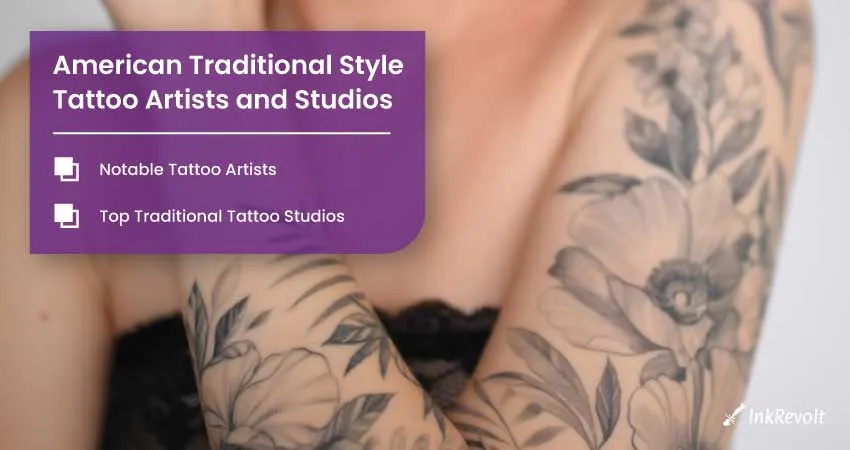
Finding the right tattoo artist and studio is essential for creating a high-quality American Traditional Tattoo. In this section, we’ll explore some renowned artists and studios that specialize in this style, as well as tips for choosing the perfect one for your needs.
Notable Tattoo Artists
Several tattoo artists have made a name for themselves in the world of American Traditional Tattoos. Here are a few noteworthy names to consider:
- Sailor Jerry (Norman Keith Collins): A pioneer of the American Traditional Tattoo style, Sailor Jerry’s work has had a lasting impact on the industry. While he is no longer with us, his designs continue to inspire and influence modern tattoo artists.
- Bert Krak: Based in New York City, Bert Krak is a highly respected tattoo artist known for his clean lines, bold colors, and attention to detail in American Traditional Tattoos.
- Myke Chambers: Renowned for his mastery of the American Traditional Tattoo style, Myke Chambers has a distinctive approach that combines classic motifs with modern techniques.
- Blake Owens: Based in Nashville, Tennessee, Blake Owens is a talented tattoo artist with a flair for American Traditional Tattoos. His work showcases bold colors and clean lines, which make his designs stand out.
- Erik Anderson: Located in Lincoln, Nebraska, Erik Anderson is known for his impressive American Traditional Tattoos. With a keen eye for detail and a passion for the style, Anderson’s tattoos capture the essence of this classic art form.
- Matt Howse: Working out of San Francisco, California, Matt Howse is an experienced tattoo artist with a focus on American Traditional Tattoos. His work is characterized by strong lines and vibrant colors, reflecting the iconic nature of the style.
- Jacob Bryan: Hailing from Indianapolis, Indiana, Jacob Bryan is a skilled artist with a specialization in American Traditional Tattoos. His designs are both intricate and bold, embodying the spirit of the traditional style.
- Gypsy Drew Linden: Based in Brooklyn, New York, Gypsy Drew Linden is a renowned tattoo artist with a penchant for American Traditional Tattoos. Her work blends classic elements with a modern twist, resulting in striking and unique designs.
- Tim Shafer: Operating in Jacksonville, Florida, Tim Shafer is a talented artist with expertise in American Traditional Tattoos. His work showcases the timeless appeal of the style, with vivid colors and clean lines that are sure to impress.
- Eric Jones: Located in San Francisco, California, Eric Jones is an accomplished tattoo artist with a passion for American Traditional Tattoos. His designs capture the essence of the style with striking imagery and expert craftsmanship.
Top Traditional Tattoo Studios
Several tattoo studios are recognized for their expertise in American Traditional Tattoos. Some of the most reputable establishments include:
- Smith Street Tattoo Parlour: Located in Brooklyn, New York, Smith Street Tattoo Parlour is known for its talented roster of artists, including Bert Krak, who specialize in American Traditional Tattoos.
- Black Heart Tattoo: Based in San Francisco, California, Black Heart Tattoo is home to several skilled artists with a passion for American Traditional Tattoos.
- Kings Avenue Tattoo: With locations in New York City and Long Island, Kings Avenue Tattoo is a respected studio that offers high-quality American Traditional Tattoos by experienced artists.
Conclusion
American Traditional Tattoos hold a storied history and remain a popular choice for those seeking a timeless, visually striking tattoo. By understanding the style’s origins, characteristics, and symbolism, you can create a unique and meaningful design that pays homage to this classic art form. Remember to choose a skilled artist, prepare for your session, and follow proper aftercare to ensure a successful tattoo experience that will stand the test of time.
